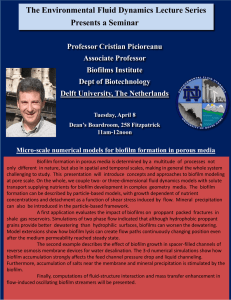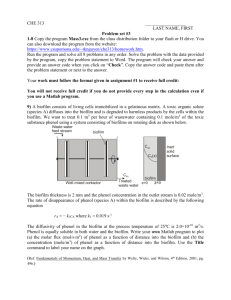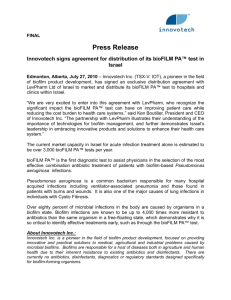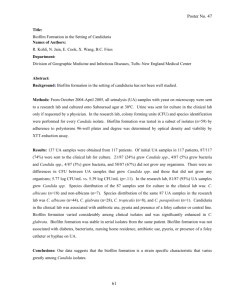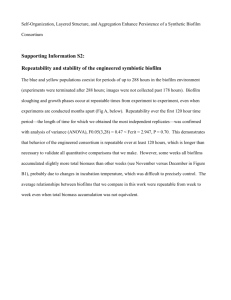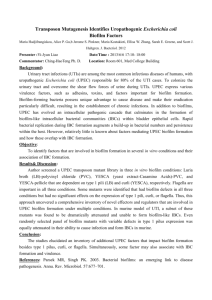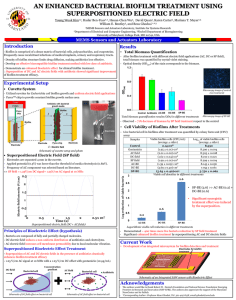Supporting Information “Graphene Biotransistor Interfaced with a Nitrifying Biofilm”
advertisement
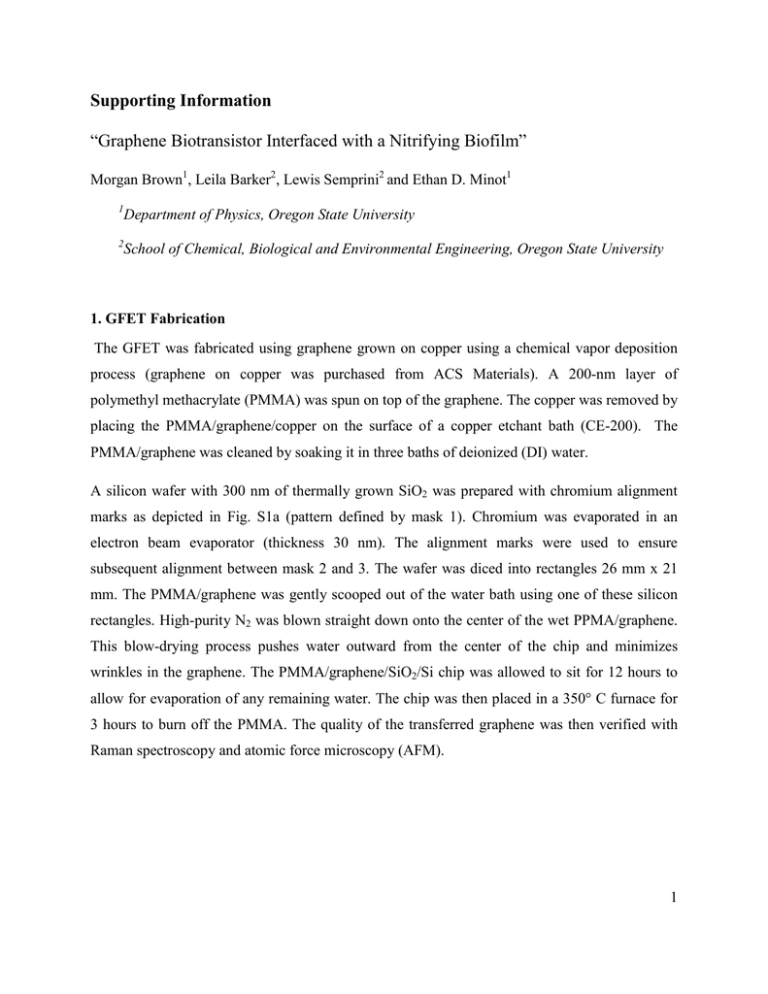
Supporting Information “Graphene Biotransistor Interfaced with a Nitrifying Biofilm” Morgan Brown1, Leila Barker2, Lewis Semprini2 and Ethan D. Minot1 1 Department of Physics, Oregon State University 2 School of Chemical, Biological and Environmental Engineering, Oregon State University 1. GFET Fabrication The GFET was fabricated using graphene grown on copper using a chemical vapor deposition process (graphene on copper was purchased from ACS Materials). A 200-nm layer of polymethyl methacrylate (PMMA) was spun on top of the graphene. The copper was removed by placing the PMMA/graphene/copper on the surface of a copper etchant bath (CE-200). The PMMA/graphene was cleaned by soaking it in three baths of deionized (DI) water. A silicon wafer with 300 nm of thermally grown SiO2 was prepared with chromium alignment marks as depicted in Fig. S1a (pattern defined by mask 1). Chromium was evaporated in an electron beam evaporator (thickness 30 nm). The alignment marks were used to ensure subsequent alignment between mask 2 and 3. The wafer was diced into rectangles 26 mm x 21 mm. The PMMA/graphene was gently scooped out of the water bath using one of these silicon rectangles. High-purity N2 was blown straight down onto the center of the wet PPMA/graphene. This blow-drying process pushes water outward from the center of the chip and minimizes wrinkles in the graphene. The PMMA/graphene/SiO2/Si chip was allowed to sit for 12 hours to allow for evaporation of any remaining water. The chip was then placed in a 350° C furnace for 3 hours to burn off the PMMA. The quality of the transferred graphene was then verified with Raman spectroscopy and atomic force microscopy (AFM). 1 Figure S1. Lithography processes. A positive photoresist (MicroChem S1813) was used on top of a lift off release layer (MicroChem LOR3A). After light exposure, the photoresist was developed using AZ 300 MIF developer. Stripping of photoresist was accomplished using MicroChem Remover PG. Mask 2 was used to pattern the graphene (Fig. S1b). Patterned photoresist protected small strips of graphene while the chip was placed into an RF plasma cleaner with oxygen gas. The photoresist then removed by MicroChem Remover PG, followed by a rinse in isopropyl alcohol (IPA) and DI water. The quality of the resulting graphene strips was verified with Raman spectroscopy. Mask 3 was used to pattern thin-film metal electrodes onto the graphene (Fig. S1c). Large contact pads (3 mm x 3 mm) connect to traces that are 40 m wide. An electron beam evaporator was used for the metal deposition (2 nm Cr and 30 nm gold). After metal deposition, the chip was removed from the evaporator and the contact pads were covered with a shadow mask. The electron beam evaporator was then used to deposit 70 nm of SiO2 over the 40 m wide Au traces. The photoresist was then removed by MicroChem Remover PG, followed by a rinse in isopropyl alcohol (IPA) and DI water. The completed GFET devices were then checked with Raman and electrically tested. 2 Silver paint was used to attach wire leads to the thin-film metal electrodes. The exposed wire, silver paint and metal electrodes were all encased in silicone sealant to electrically isolate the GFET sensor circuit from liquids. 2. Determining the selectivity of the GFET pH sensor 2.1 GFET sensor in a petri dish (no biofilm on the sensor) The same sensor device used for biofilm experiments (see main text) was challenged with NH2, ATU, NH2OH and NaN3 to determine whether the sensor is selective to changes in pH. For this control experiment, biological processes were eliminated by killing the biofilm and washing it off the sensor. The conditions of the biofilm experiment were mimicked: the sensor was operated in the petri dish and aliquots of chemicals were added to the side of the petri dish. Figure S2 shows that the sensor does not respond to any of the stimulating chemicals that were used during the biofilm experiments. 3 Figure S2. Response of the bare GFET sensor (no biofilm present) in 6 mM HEPES buffer to aliquots of NH4, ATU, NH2OH, and NaN3 resulting in 1mM, 3mM, 1mM and 1 mM concentrations respectively. 2.2 GFET sensor in a flow cell Additional control experiments were performed on GFET sensors using a homebuilt microfluidic flow cell. These flow cell experiments used a smaller GFET device geometry (sensor area 3 m x 3 m). The device was submerged in a bath of 10 M bovine serum albumin for 1 hour to mimic the extracellular matrix of the biofilm. The first test verified that upward and downward steps in pH are faithfully reported by the sensor (Fig S3). This test also verified that pH sensitivity is not affected by the presence of NH4+, NH2OH, or NO2-. The concentrations of NH4+, NH2OH, or NO2- were chosen to mimic levels found in our biofilm experiments. Figure S3. Changes in Isd as pH is cycled between 8 and 7. All data was taken using 6 mM HEPES buffer. In shaded regions, an additional chemical was added to the buffer: 1 mM NH4, 1 mM NH2OH, and 0.4 mM NHO2-. The second test verified that changes in dissolved oxygen (DO) levels do not affect Isd (Fig. S3). Based on these result, we conclude that pH readings made using the GFET sensor are robust, even when DO levels are changing. 4 Figure S4. Changes in Isd as the dissolved oxygen content was cycled between 9 mg/L, and < 3 mg/L. The pH sensitivity of this device was ~ 0.5 A/pH. 3. Establishing the biofilm on the sensor The characteristics of the GFET sensor was monitored during the initial phase of biofilm growth (Fig. S5). A liquid suspension of N. Europea was added to the petri dish at time t = 0. We observed gradual evolution of V as the biofilm was established. Figure S5. The shift in transistor curve, V, measured after inoculating the GFET sensor with a liquid suspension of N. Europea at t = 0. The buffer was 30 mM HEPES with trace nutrients for growth. 5 4. Verifying metabolic activity of the biofilm After the biofilm was established on the GFET sensor we verified that the biofilm was converting NH3 to NO2- and acidifying the environment. In the main text we show the response of the sensor during the 80 minutes after addition of NH4+. Fig. S6 shows the nitrite levels and sensor response for the next 100 hours. Complete conversion of NH3 to NO2- occurs after approximately 100 hours. Figure S6. Metabolic activity of the biofilm monitored by measuring the nitrite (NO2-) concentration (upper panel) and the GFET-based pH sensor (lower panel). At the start of the test, the biofilm in 6 mM HEPES buffer was dosed with 31 mol of (NH4)2SO4, which yielded an initial NH4+ concentration of approximately 1 mM. The metabolic activity of the biofilm produces NO2- and a decrease in pH. The increase in NO2indicates complete utilization of the added NH4+ during the test. 5. Long-term hydroxylamine test A series of three NH2OH additions were performed (two of these are shown in the main text). Upon each addition, the concentration of NH2OH in the petri dish was increased by 1 mM. Measurements of nitrite levels (Fig S7) show that approximately 0.7 mM of nitrite was produced following each addition (approximately 70% conversion of NH2OH). After the third addition, the biocide NaN3 was added. 6 Figure S7. Changes in pH and nitrite levels resulting from NH2OH additions. The utilization of NH3 by the AMO enzyme has been inhibited by ATU. Following the final addition of NH2OH the biofilm was exposed to the biocide NaN3. The buffer is 6 mM HEPES. 6. Estimating diffusion time scales The time scale for diffusion can be estimated from the experimental geometry and the diffusion constant for NH3 and H+. Stewart et al.20 calculated the time to 90 % equilibrium for a flat biofilm slab at t90 = 1.03L2/De, where L is the biofilm thickness and De is the effective diffusion coefficient. Diffusion coefficients are typically reduced inside the biofilm compared to the bulk. For small molecules, De ~ 0.8Dbulk.20 For NH3, we estimate De ~ 1.6 x 10-5 cm2/s, and for H+ we estimate De ~ 7 x 10-5 cm2/s. For an assumed biofilm thickness of 0.1 cm, we estimate t90 = 8 minutes for NH3. Since H+ is distributed throughout the biofilm the boundary condition for this simple solution does not apply. However, with the higher diffusion coefficient we would expect shorter time scales for H+ compared to NH3. The equilibration times would be further lengthened by the boundary layer between the biofilm and the bulk fluid. 6. Comparison with microprobe measurements 7 Lanchnor et al.17 report the results of microprobe measurements and numerical modeling of dissolved oxygen (DO) and pH within a biofilm of N. europaea. The studies were done using a buffer strength of 1 mM HEPES (lower than to the 6 mM buffer used for experiments reported here) and with a biofilm thickness of 300 M. The measured DO profiles indicate that when 5 mM of NH4+ is present in the bulk solution, DO is completely depleted inside the biofilm (at a depth of 300 m). Dissolved oxygen is also depleted and limits the rate of metabolism inside the biofilm when using 1.5 mM and 0.5 mM of NH4+ (similar to the 1 mM concentration used for the experiments reported here). They observed a decrease in pH within the biofilm from 7.8 to 6.6 when 1.5 mM of NH4+ was added. 8
